
Copyright (c) 2001 Hans-Peter Nilsson.
Permission is granted to copy, distribute and/or modify this document
under the terms of the GNU Free Documentation License, Version 1.1
or any later version published by the Free Software Foundation;
with the Invariant Sections being just "Location of the original",
with no Front-Cover Texts, and with no Back-Cover Texts.
A copy of the license is included in the section entitled "GNU
Free Documentation License".
The programs in the slides are put in the public domain; the slides
themselves are covered by the GNU Free Documentation License as above.
This document is a webbification of some slides and notes presented at
the MMIXfest
2001, October 6 in Munich, Germany, hosted by the Computer Science and
Mathematics Department, Munich University of Applied Sciences.
You are encouraged to report errors in the original document or
opinions about it to
hp@bitrange.com.
Contents
The original of this document is located at
http://bitrange.com/mmix/mmixfest-2001/mmixabi.html.
(No changes since the original webbification on
2001-10-10.)
I'll present an ABI based on Knuth's documents. I want your
opinions about some details where I'm undecided. I'll also
sketch a few details of an alternative ABI.
Performance of programs for the MMIX architecture relies on
keeping as many variables as possible in registers, to minimize
memory accesses by other means than through the register stack
and instruction fetches. So first hand, registers should be
used rather than a traditional memory stack.
Another goal is for the assembly code to be usable as input
for further modification by a human. The generated code should
as far as possible be compatible with mmixal and conventions in
Knuth's texts. There are currently (2001-10-10) some
non-conformance issues, which will be fixed wherever
possible.

It is described (in [ref 1]) that
parameters are usually passed in registers $0 and up, as seen by
the called function. Further, the return address is passed in
rJ, using PUSHJ and PUSHGO for function calls and POP for
returning ([ref 3]). Return values are put
in $0 and up, as seen by the returning (called) function.
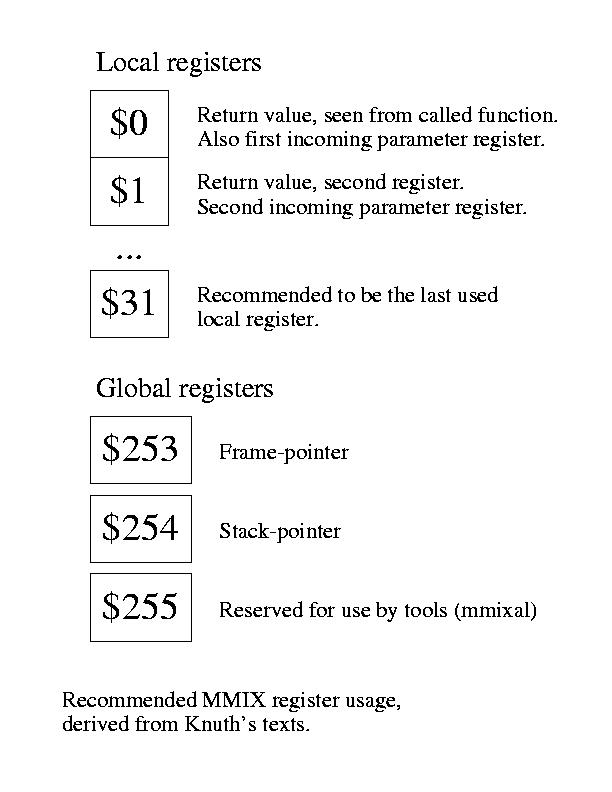
In [ref 2], it is mentioned that $255 is
used by mmixal for instruction expansion under control of the
-x option. This happens when loading out-of-range addresses,
making register $255 unsuitable for literal use in assembly
programs. At the same place, it is suggested that functions
that need a memory stack can use $254 as a stack pointer and
when necessary, $253 as a frame-pointer.

The number of local registers (the value of special register
rG), is defined to never be lower than 32. It is also
recommended (in [ref 1]) that a program
should not assume more than 32 available local registers. This
number is higher than most human-written C-functions will use
anyway. Therefore, the number of incoming or outgoing registers
used for parameters cannot reasonably be higher than 32. In an
attempt to keep things simple (and to work around restrictions
in GCC), it seemed best to split that number even for incoming
and outgoing parameters; the number of registers used for
parameters is 16.
Hopefully, this should also minimize the number of register
moves necessary to get incoming registers "out-of-the-way" when
calling other functions.
Please note that register $16 being an outgoing parameter
register is just a first approximation. I'll explain briefly
the GCC-related issues later. The
17:th parameter and beyond are passed on the stack, with $254
(the stack-pointer) pointing to the first parameter in the
called function.
Just as mmixal does, the GNU binutils uses register $255 for
its own purposes when loading addresses. GCC also uses it for
temporary purposes in some cases, but only for instructions that
the assembler and linker will not expand.
The stack pointer $254 is set up in the code between Main and
main, and must have the same value when a function returns as
when it was entered.
If register $253, the suggested frame-pointer, is used in a
function, it must likewise be saved so it has the same value at
function exit as at function entry.
The GCC implementation reserves a few registers.
There's a GCC extension for nested functions, that for some
codes circumstances need to pass a context pointer; a pointer to
the local variables of the enclosing function when a pointer to
a nested function is passed to another function[1]. That pointer is passed in register
$252.
Register $251 is used for the structure return pointer.
Registers $247..$250 are used for C++ exception handling, and
registers $231.. $246 are reserved for the GNU ABI. There is no
need for a function to preserve these register values, but it
must be prepared that a called function may change them.
This is just the current (2001-10-10) work-in-progress
mapping. These allocations are not final, and some of the uses
can certainly share the same register. For the imaginary
typical MMIX programmer these allocations should not matter, as
they do not collide with GREG-allocated registers (unless the
program is short on registers).
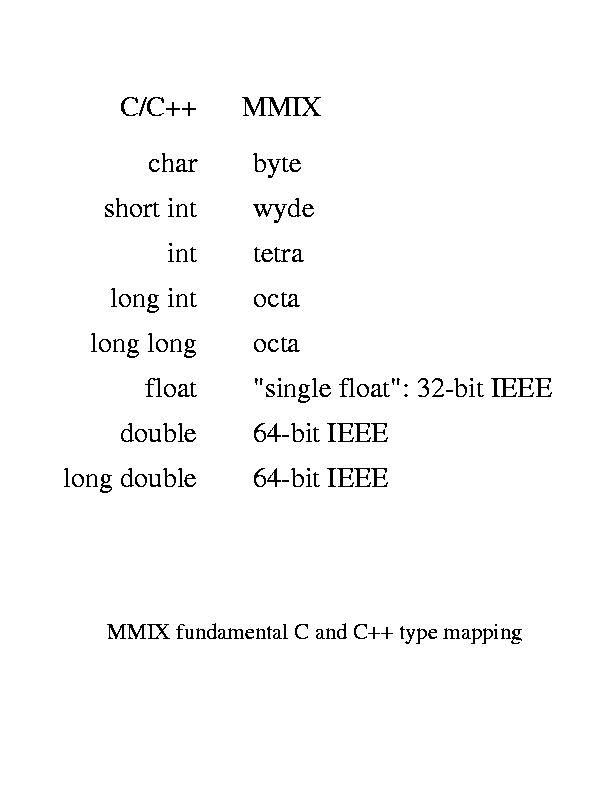
MMIX can handle 8, 16, 32 and 64-bit data. A reasonable
mapping of C types exposes all these sizes so e.g. a C
programmer wanting to write for MMIX can do it simply by using
standard types[2]. The fundamental address
unit type in C is char (sizeof char is always 1), so BYTE maps
naturally to it. The C "char" type is by default signed,
because this is the case for most gcc ports and therefore would
presumably lead to the fewest compatibility problems. The rest
of the normal C integer types are "short int", "int" and "long
int". They naturally map to wyde, tetrabyte and octabyte.
Incidentally, this is the same mapping as the alpha gcc port
uses. The gcc type "long long"[3] has to
map to octabyte, otherwise cross-compilation from a 32-bit host
is not possible. This is a gcc restriction, but might not
matter too much, since on a "long long" is usually also 64 bits,
this being natural for existing 32-bit hosts.
The normal C floating point types are float, double and long
double. MMIX has 64-bit IEEE floating point quantities and
limited operations on 32-bit quantities, "short floats". They
naturally map to double and float, with long double an alias for
double.
Each of the fundamental types must be mapped to an address at
least a multiple of its size, so called "naturally aligned". To
be theoretically addressable with a GETA, individual variables
are aligned to tetrabyte alignment.

Similarly for structures, the structure layout has members
naturally aligned, with padding inserted where necessary. The
alignment of a structure is that of its largest contained type.
The size is a multiple of that type, with padding inserted at
the end of the structure.
If a parameter fits in a register, it is passed by-value,
with integer types extended to 64 bits by the caller.
Otherwise, it is passed by reference (as a pointer to the
original), and the called function has to copy it, in case it
needs a local modifiable copy.
The same goes for parameters passed on the stack; integer
types are promoted, passed as 64 bits, with larger-than-64-bit
types passed by reference.
Scalar values are returned in $0 as seen by the calling
function. We usually don't have to worry about the register
hole.
There is an exception: complex values together larger than 64
bits are returned in $0 and $1 as seen by the calling function.
For these multi-register return values, the called function
compensates for the hole, so the calling function sees the
register with $0 being the natural first part; like the order
allocated for registers.

Structures are returned specially. The caller passes a pointer
to an area where the structure contents is to be stored by the
called function, regardless of the structure size. The
structure-return pointer is passed in register $251.

While it's certainly possible to implement special calling
conventions for functions declared to take a variable number of
parameters, like printf, there is no need to. The called stdarg
function will arrange to map parameter registers to be
accessible as a va_list (usually an array). The called function
will have to push the parameters that were passed in registers
onto the stack before processing them. There's an implicit
assumption that stdarg functions don't have to be optimal in
terms of speed. Also, this yields simple, easy-to-understand
code.
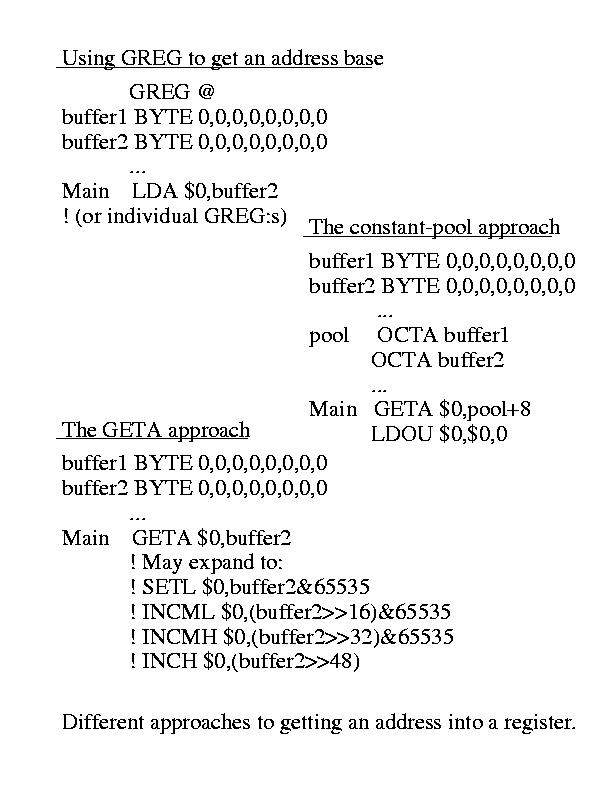
When accessing memory, the address has to get into a register
somehow. A common convention is to allocate a register with
GREG at the start of a number of memory variables, and use a
base-plus-offset expression to translate the address into a
register plus offset. That method is restricted to about two
hundred such variables (or areas of variables, 256 bytes long)
per program.
The ARM, Hitachi SH and others use "constant pools", where
each far-away address is kept nearby the code; its
address loaded with a GETA equivalent, then using a LDOU to load
the real address. On the other hand, these memory accesses
appear out of sequence compared to instruction fetches and the
"real" memory accesses, a reason to avoid that solution, at
least when modeling real hardware. Also, that would mean a
GETA and LDOU with the address taking up an octabyte:
disregarding possible sharing of addresses, this equals a
four-instruction sequence, at least in size.
I chose to use GETA for address loading, leaving it to the
assembler and linker to expand it when necessary. This is
counter to the goal of using the same conventions as for
manually written assembly code. Therefore I'll implement the
GREG/base-plus-offset approach as an option, default for
standard applications. Anyway, it seems good to at least
optionally be lean on GREG allocations, using the GETA
approach.
Some ports prepend symbols with underscores to disambiguate
register names, but there's no need for that with MMIX. Some
use dollar signs ($) or dots (.) to protect compiler-generated
symbols; the MMIX port uses colon (:) at strategic places. (See
the static chain example.)
A few properties and limitations of gcc affect the MMIX port
badly.
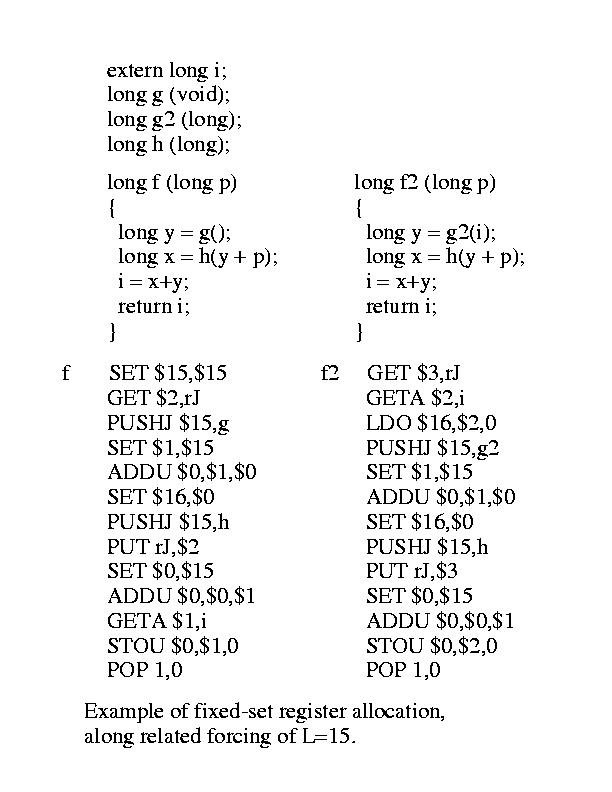
As a rule, GCC considers the set of registers that can hold
parameters and the set of return-value registers constant. Two
other important sets, are the set of call-saved registers and
call-clobbered registers. While GCC is written for these sets
being constant, they should be chosen dynamically for best MMIX
code (even per-call within a function), to e.g. avoid setting L
higher than necessary. Unfortunately the possibility of making
these properties dynamic, or one a function of the other, is
limited at best. For the GCC MMIX port, these properties *are*
currently (2001-10-10) constant: registers $0..$14 are
call-saved, and $16..$31 are call-clobbered.
Changing these parts of gcc would be a major rewrite.
It is reasonably simple, that at a final pass "rename"
registers, for example to close an unused gap between the end of
the call-saved registers and the outgoing parameter registers.
There's hope that the end result will be reasonably near an
optimal register allocation, like the one a skilled human would
do.
After mentioning the register allocation limitations, I think
I should cheer you up by mentioning that GCC has some provisions
for allocating global variables in registers. It doesn't do it
automatically, but it should be reasonably simple to interface
global register definitions with GREG allocations. I have
however not investigated this thoroughly.
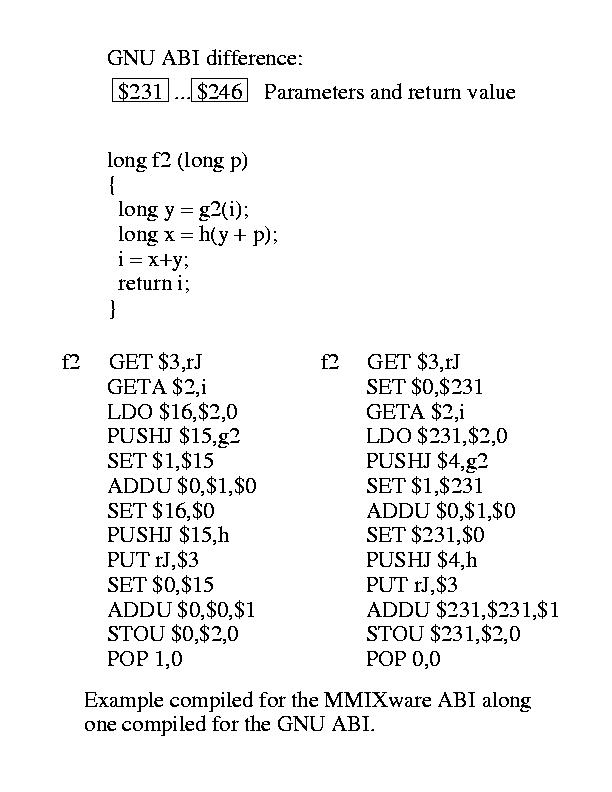
To simplify development of the port, I started with a
traditional ABI, one where parameters are passed in
call-clobbered global registers (same for called and calling
function) and where the return value is returned in primarily
the first parameter registers. I call this the GNU ABI.
At the moment I don't have any performance figures. Though in
my experience, the number of register moves are kept to a
minimum if incoming and outgoing parameter register and the
primary return value register are the same. On the other hand
MMIX instructions being three-operand lessens the importance of
that.
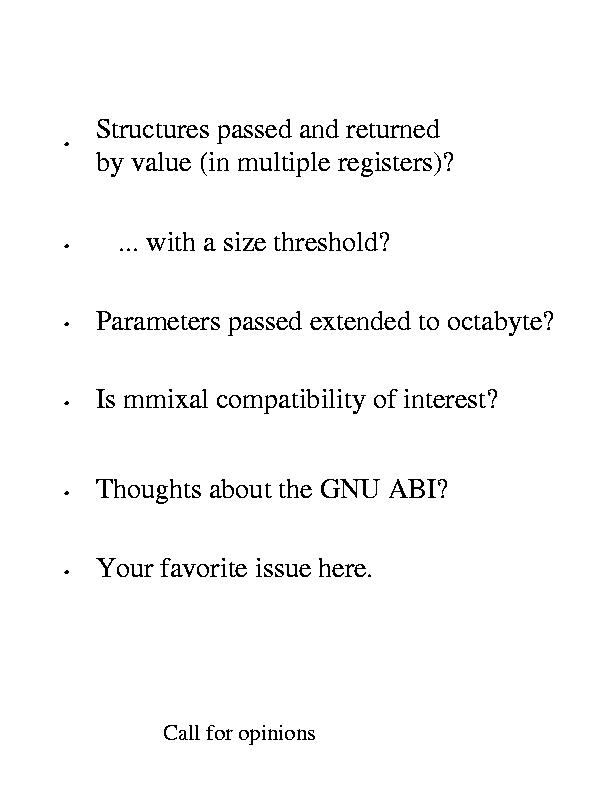
Should structures be passed by-value in multiple registers?
If so, there should preferably be a size-threshold. What
should be the structure-size threshold for that?
Who should extend passed integers, caller or called function?
The 64-bit extension of passed integer types is mainly for ease
of use; the programmer who interfaces assembly code to
compiler-generated code does not have to remember the exact type
passed, "it's an integer, extend or truncate it and pass it in a
register" is sufficient for most use. I haven't showed you
actual examples of this, because there are some related bugs
that cause the code to be quite ugly. That's why I've used
"long" in most examples.
Is it useful that the generated code is as mmixal-compatible
as possible, even if it results in non-optimal code?
What are your thoughts about the GNU ABI?
The sources for these references can be found at
http://www-cs-staff.Stanford.EDU/~knuth/mmix-news.html and
(probably, I have not checked) in the MMIX
book.
- mmix-doc.ps, section 29, page 23
- mmixal-intro.ps, section 18, page 8
- mmix-doc.ps, section 18, page 13
The static chain register is necessary when a
function pointer to the nested function is passed to another function, the
nested function accessing variables in the enclosed function. The passed
function pointer for the nested function is actually points to another
piece of code, a trampoline, where the static chain register is
loaded. The trampoline then jumps to the nested function, as can be seen
in the figure below:

In the "new" C99 standard, there can be
names for types of specific sizes, like int64_t, accessible
through the <stdint.h> header file. Mapping ordinary C
types to specific sizes may therefore not strictly be
necessary.
The type long long and its
unsigned variant are standard types in the C99
standard.
Version 1.1, March 2000
Copyright (C) 2000 Free Software Foundation, Inc.
59 Temple Place, Suite 330, Boston, MA 02111-1307 USA
Everyone is permitted to copy and distribute verbatim copies
of this license document, but changing it is not allowed.
0. PREAMBLE
The purpose of this License is to make a manual, textbook, or other
written document "free" in the sense of freedom: to assure everyone
the effective freedom to copy and redistribute it, with or without
modifying it, either commercially or noncommercially. Secondarily,
this License preserves for the author and publisher a way to get
credit for their work, while not being considered responsible for
modifications made by others.
This License is a kind of "copyleft", which means that derivative
works of the document must themselves be free in the same sense. It
complements the GNU General Public License, which is a copyleft
license designed for free software.
We have designed this License in order to use it for manuals for free
software, because free software needs free documentation: a free
program should come with manuals providing the same freedoms that the
software does. But this License is not limited to software manuals;
it can be used for any textual work, regardless of subject matter or
whether it is published as a printed book. We recommend this License
principally for works whose purpose is instruction or reference.
1. APPLICABILITY AND DEFINITIONS
This License applies to any manual or other work that contains a
notice placed by the copyright holder saying it can be distributed
under the terms of this License. The "Document", below, refers to any
such manual or work. Any member of the public is a licensee, and is
addressed as "you".
A "Modified Version" of the Document means any work containing the
Document or a portion of it, either copied verbatim, or with
modifications and/or translated into another language.
A "Secondary Section" is a named appendix or a front-matter section of
the Document that deals exclusively with the relationship of the
publishers or authors of the Document to the Document's overall subject
(or to related matters) and contains nothing that could fall directly
within that overall subject. (For example, if the Document is in part a
textbook of mathematics, a Secondary Section may not explain any
mathematics.) The relationship could be a matter of historical
connection with the subject or with related matters, or of legal,
commercial, philosophical, ethical or political position regarding
them.
The "Invariant Sections" are certain Secondary Sections whose titles
are designated, as being those of Invariant Sections, in the notice
that says that the Document is released under this License.
The "Cover Texts" are certain short passages of text that are listed,
as Front-Cover Texts or Back-Cover Texts, in the notice that says that
the Document is released under this License.
A "Transparent" copy of the Document means a machine-readable copy,
represented in a format whose specification is available to the
general public, whose contents can be viewed and edited directly and
straightforwardly with generic text editors or (for images composed of
pixels) generic paint programs or (for drawings) some widely available
drawing editor, and that is suitable for input to text formatters or
for automatic translation to a variety of formats suitable for input
to text formatters. A copy made in an otherwise Transparent file
format whose markup has been designed to thwart or discourage
subsequent modification by readers is not Transparent. A copy that is
not "Transparent" is called "Opaque".
Examples of suitable formats for Transparent copies include plain
ASCII without markup, Texinfo input format, LaTeX input format, SGML
or XML using a publicly available DTD, and standard-conforming simple
HTML designed for human modification. Opaque formats include
PostScript, PDF, proprietary formats that can be read and edited only
by proprietary word processors, SGML or XML for which the DTD and/or
processing tools are not generally available, and the
machine-generated HTML produced by some word processors for output
purposes only.
The "Title Page" means, for a printed book, the title page itself,
plus such following pages as are needed to hold, legibly, the material
this License requires to appear in the title page. For works in
formats which do not have any title page as such, "Title Page" means
the text near the most prominent appearance of the work's title,
preceding the beginning of the body of the text.
2. VERBATIM COPYING
You may copy and distribute the Document in any medium, either
commercially or noncommercially, provided that this License, the
copyright notices, and the license notice saying this License applies
to the Document are reproduced in all copies, and that you add no other
conditions whatsoever to those of this License. You may not use
technical measures to obstruct or control the reading or further
copying of the copies you make or distribute. However, you may accept
compensation in exchange for copies. If you distribute a large enough
number of copies you must also follow the conditions in section 3.
You may also lend copies, under the same conditions stated above, and
you may publicly display copies.
3. COPYING IN QUANTITY
If you publish printed copies of the Document numbering more than 100,
and the Document's license notice requires Cover Texts, you must enclose
the copies in covers that carry, clearly and legibly, all these Cover
Texts: Front-Cover Texts on the front cover, and Back-Cover Texts on
the back cover. Both covers must also clearly and legibly identify
you as the publisher of these copies. The front cover must present
the full title with all words of the title equally prominent and
visible. You may add other material on the covers in addition.
Copying with changes limited to the covers, as long as they preserve
the title of the Document and satisfy these conditions, can be treated
as verbatim copying in other respects.
If the required texts for either cover are too voluminous to fit
legibly, you should put the first ones listed (as many as fit
reasonably) on the actual cover, and continue the rest onto adjacent
pages.
If you publish or distribute Opaque copies of the Document numbering
more than 100, you must either include a machine-readable Transparent
copy along with each Opaque copy, or state in or with each Opaque copy
a publicly-accessible computer-network location containing a complete
Transparent copy of the Document, free of added material, which the
general network-using public has access to download anonymously at no
charge using public-standard network protocols. If you use the latter
option, you must take reasonably prudent steps, when you begin
distribution of Opaque copies in quantity, to ensure that this
Transparent copy will remain thus accessible at the stated location
until at least one year after the last time you distribute an Opaque
copy (directly or through your agents or retailers) of that edition to
the public.
It is requested, but not required, that you contact the authors of the
Document well before redistributing any large number of copies, to give
them a chance to provide you with an updated version of the Document.
4. MODIFICATIONS
You may copy and distribute a Modified Version of the Document under
the conditions of sections 2 and 3 above, provided that you release
the Modified Version under precisely this License, with the Modified
Version filling the role of the Document, thus licensing distribution
and modification of the Modified Version to whoever possesses a copy
of it. In addition, you must do these things in the Modified Version:
- A. Use in the Title Page (and on the covers, if any) a title distinct
from that of the Document, and from those of previous versions
(which should, if there were any, be listed in the History section
of the Document). You may use the same title as a previous version
if the original publisher of that version gives permission.
- B. List on the Title Page, as authors, one or more persons or entities
responsible for authorship of the modifications in the Modified
Version, together with at least five of the principal authors of the
Document (all of its principal authors, if it has less than five).
- C. State on the Title page the name of the publisher of the
Modified Version, as the publisher.
- D. Preserve all the copyright notices of the Document.
- E. Add an appropriate copyright notice for your modifications
adjacent to the other copyright notices.
- F. Include, immediately after the copyright notices, a license notice
giving the public permission to use the Modified Version under the
terms of this License, in the form shown in the Addendum below.
- G. Preserve in that license notice the full lists of Invariant Sections
and required Cover Texts given in the Document's license notice.
- H. Include an unaltered copy of this License.
- I. Preserve the section entitled "History", and its title, and add to
it an item stating at least the title, year, new authors, and
publisher of the Modified Version as given on the Title Page. If
there is no section entitled "History" in the Document, create one
stating the title, year, authors, and publisher of the Document as
given on its Title Page, then add an item describing the Modified
Version as stated in the previous sentence.
- J. Preserve the network location, if any, given in the Document for
public access to a Transparent copy of the Document, and likewise
the network locations given in the Document for previous versions
it was based on. These may be placed in the "History" section.
You may omit a network location for a work that was published at
least four years before the Document itself, or if the original
publisher of the version it refers to gives permission.
- K. In any section entitled "Acknowledgements" or "Dedications",
preserve the section's title, and preserve in the section all the
substance and tone of each of the contributor acknowledgements
and/or dedications given therein.
- L. Preserve all the Invariant Sections of the Document,
unaltered in their text and in their titles. Section numbers
or the equivalent are not considered part of the section titles.
- M. Delete any section entitled "Endorsements". Such a section
may not be included in the Modified Version.
- N. Do not retitle any existing section as "Endorsements"
or to conflict in title with any Invariant Section.
If the Modified Version includes new front-matter sections or
appendices that qualify as Secondary Sections and contain no material
copied from the Document, you may at your option designate some or all
of these sections as invariant. To do this, add their titles to the
list of Invariant Sections in the Modified Version's license notice.
These titles must be distinct from any other section titles.
You may add a section entitled "Endorsements", provided it contains
nothing but endorsements of your Modified Version by various
parties--for example, statements of peer review or that the text has
been approved by an organization as the authoritative definition of a
standard.
You may add a passage of up to five words as a Front-Cover Text, and a
passage of up to 25 words as a Back-Cover Text, to the end of the list
of Cover Texts in the Modified Version. Only one passage of
Front-Cover Text and one of Back-Cover Text may be added by (or
through arrangements made by) any one entity. If the Document already
includes a cover text for the same cover, previously added by you or
by arrangement made by the same entity you are acting on behalf of,
you may not add another; but you may replace the old one, on explicit
permission from the previous publisher that added the old one.
The author(s) and publisher(s) of the Document do not by this License
give permission to use their names for publicity for or to assert or
imply endorsement of any Modified Version.
5. COMBINING DOCUMENTS
You may combine the Document with other documents released under this
License, under the terms defined in section 4 above for modified
versions, provided that you include in the combination all of the
Invariant Sections of all of the original documents, unmodified, and
list them all as Invariant Sections of your combined work in its
license notice.
The combined work need only contain one copy of this License, and
multiple identical Invariant Sections may be replaced with a single
copy. If there are multiple Invariant Sections with the same name but
different contents, make the title of each such section unique by
adding at the end of it, in parentheses, the name of the original
author or publisher of that section if known, or else a unique number.
Make the same adjustment to the section titles in the list of
Invariant Sections in the license notice of the combined work.
In the combination, you must combine any sections entitled "History"
in the various original documents, forming one section entitled
"History"; likewise combine any sections entitled "Acknowledgements",
and any sections entitled "Dedications". You must delete all sections
entitled "Endorsements."
6. COLLECTIONS OF DOCUMENTS
You may make a collection consisting of the Document and other documents
released under this License, and replace the individual copies of this
License in the various documents with a single copy that is included in
the collection, provided that you follow the rules of this License for
verbatim copying of each of the documents in all other respects.
You may extract a single document from such a collection, and distribute
it individually under this License, provided you insert a copy of this
License into the extracted document, and follow this License in all
other respects regarding verbatim copying of that document.
7. AGGREGATION WITH INDEPENDENT WORKS
A compilation of the Document or its derivatives with other separate
and independent documents or works, in or on a volume of a storage or
distribution medium, does not as a whole count as a Modified Version
of the Document, provided no compilation copyright is claimed for the
compilation. Such a compilation is called an "aggregate", and this
License does not apply to the other self-contained works thus compiled
with the Document, on account of their being thus compiled, if they
are not themselves derivative works of the Document.
If the Cover Text requirement of section 3 is applicable to these
copies of the Document, then if the Document is less than one quarter
of the entire aggregate, the Document's Cover Texts may be placed on
covers that surround only the Document within the aggregate.
Otherwise they must appear on covers around the whole aggregate.
8. TRANSLATION
Translation is considered a kind of modification, so you may
distribute translations of the Document under the terms of section 4.
Replacing Invariant Sections with translations requires special
permission from their copyright holders, but you may include
translations of some or all Invariant Sections in addition to the
original versions of these Invariant Sections. You may include a
translation of this License provided that you also include the
original English version of this License. In case of a disagreement
between the translation and the original English version of this
License, the original English version will prevail.
9. TERMINATION
You may not copy, modify, sublicense, or distribute the Document except
as expressly provided for under this License. Any other attempt to
copy, modify, sublicense or distribute the Document is void, and will
automatically terminate your rights under this License. However,
parties who have received copies, or rights, from you under this
License will not have their licenses terminated so long as such
parties remain in full compliance.
10. FUTURE REVISIONS OF THIS LICENSE
The Free Software Foundation may publish new, revised versions
of the GNU Free Documentation License from time to time. Such new
versions will be similar in spirit to the present version, but may
differ in detail to address new problems or concerns. See
http://www.gnu.org/copyleft/.
Each version of the License is given a distinguishing version number.
If the Document specifies that a particular numbered version of this
License "or any later version" applies to it, you have the option of
following the terms and conditions either of that specified version or
of any later version that has been published (not as a draft) by the
Free Software Foundation. If the Document does not specify a version
number of this License, you may choose any version ever published (not
as a draft) by the Free Software Foundation.
To use this License in a document you have written, include a copy of
the License in the document and put the following copyright and
license notices just after the title page:
Copyright (c) YEAR YOUR NAME.
Permission is granted to copy, distribute and/or modify this document
under the terms of the GNU Free Documentation License, Version 1.1
or any later version published by the Free Software Foundation;
with the Invariant Sections being LIST THEIR TITLES, with the
Front-Cover Texts being LIST, and with the Back-Cover Texts being LIST.
A copy of the license is included in the section entitled "GNU
Free Documentation License".
If you have no Invariant Sections, write "with no Invariant Sections"
instead of saying which ones are invariant. If you have no
Front-Cover Texts, write "no Front-Cover Texts" instead of
"Front-Cover Texts being LIST"; likewise for Back-Cover Texts.
If your document contains nontrivial examples of program code, we
recommend releasing these examples in parallel under your choice of
free software license, such as the GNU General Public License,
to permit their use in free software.












